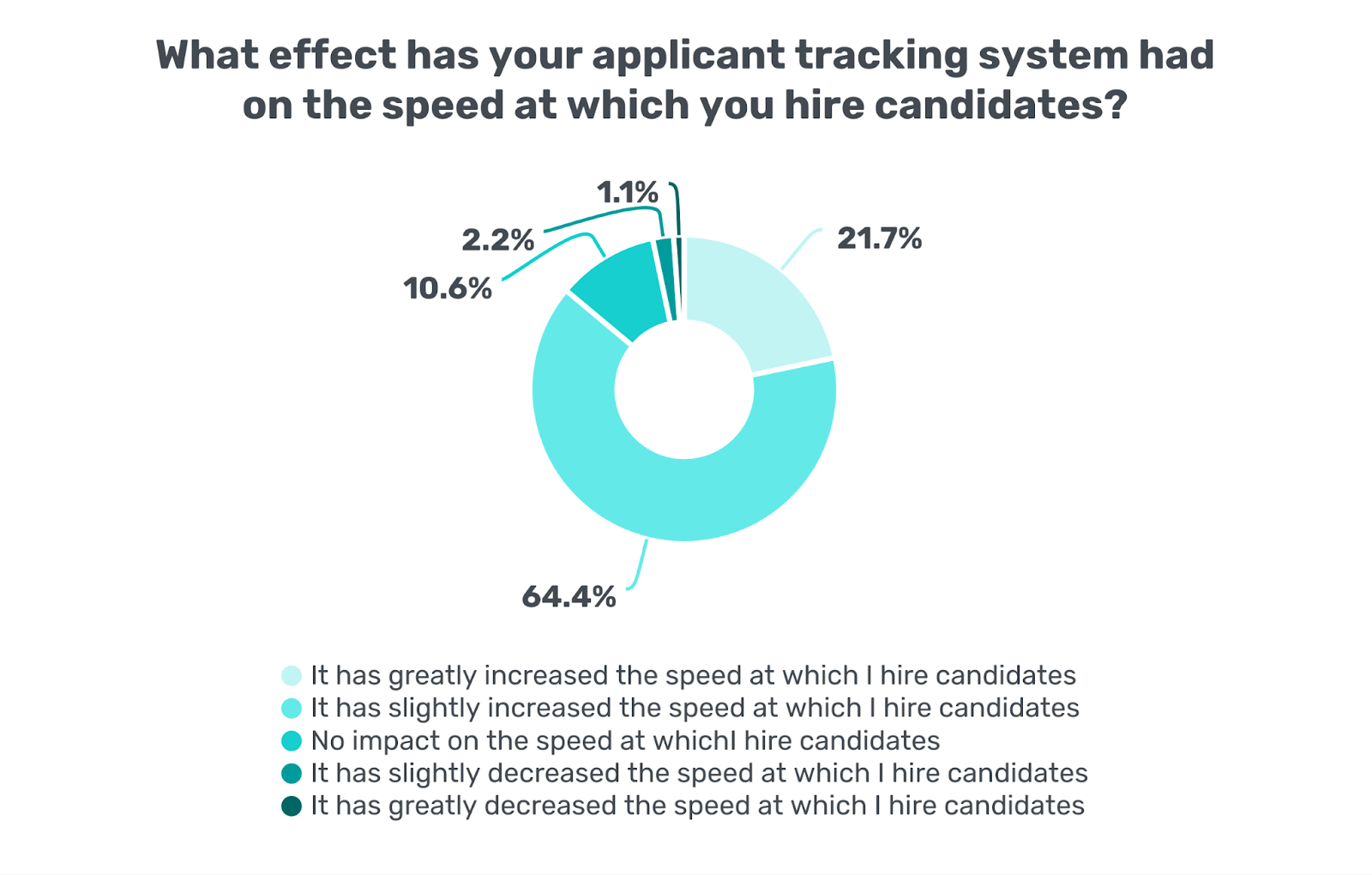Recruitment software, also known as an applicant tracking system (ATS), helps companies run all recruiting processes more effectively. Its efficiency is proven by 98.8% of Fortune 500 companies and other organizations that use ATS to help with almost all the hiring needs one can imagine.
Due to the variety of such solutions, it is hard to say how many recruiting systems are on the market today. However is there any potential for investing in the creation of an applicant tracking system in 2021?
The short answer is yes. The potential is really big. The industry shows sustained growth and is expected to reach USD 2.22 Billion by 2027.
At MindK we specialize in custom software development for HR and Recruitment and always keep track of any changes that happen in the industries. For those who want to see the big picture of the market potential, we prepared a detailed overview of the recruitment software market, its growth drivers, as well as the key industry players and competition.
What is fueling the growth of the ATS market today?
Analysis of a number of applicant tracking system reports (we will refer to them further in the article), reflects that the ATS market shows no signs of slowing down. In fact, quite the opposite. The economic crisis caused by the COVID-19 pandemic sparked even more interest from companies to applicant tracking system software.
The numbers tell the story better. Amid the lockdown, the global recruitment software market registered a Year-over-Year (YOY) growth of 4.74% in 2020. Above that, the market’s compound annual growth rate (CAGR) is expected to increase over 5% during 2020-2024.
The figures look promising, do you agree? However, to see how all pieces of the puzzle fit together let’s take a closer look at major applicant tracking system trends that drive the market.
#1. Growing trend for remote recruiting
This trend definitely results from the COVID-19 outbreak. Hiring in a crisis is no easy thing. Initially, social distancing and stay-at-home policies made filling the hot positions for keeping companies afloat a challenging task.
Remote recruiting was the go-to method for keeping the hiring process moving and protecting both recruiters and candidates.
However, a shift to virtual recruiting requires strong applicant tracking techniques and feature-rich solutions. Thus, most companies moved to automation of hiring processes and virtual interviewing tools like Microsoft Teams, Skype, Zoom, etc.
At MindK, we believe that remote recruiting is going to be a new normal in the years ahead. Those companies that have a strong candidate applicant tracking system will be able to hire and engage more talent in a shorter time span while saving time and money.
Further still, candidates are becoming more comfortable with emerging technologies. They expect robust technological expertise from employers right from the very start.
For example, Generation Z (16-26 year-olds for today) job seekers appreciate tech-savvy companies. The majority of them will not even apply for a job position if they consider that the recruitment methods of the company are outdated.

That’s why businesses focused on hiring top talents need to make the most of cutting-edge talent acquisition software. All this gently leads us to the next growth factor.
#2. Increasing demand for digitalization
The modern pace of living requires us to act with speed. In terms of recruiting, it means finding necessary people or information in minutes, get in touch fast and make decisions on the go. That’s where digital business transformation comes into play.
Digital transformation in recruitment refers to the adoption of innovative solutions to improve the hiring process. Recruitment and applicant tracking software is at the very top of this list. Embracing ATS in business enables recruiters to manage every step of the hiring process in one single place.
In general, ATS leaves behind traditional recruitment methods by means of three key parameters – time to hire, cost per hire, and the quality of hire. 86.1% of recruiting professionals admitted that the software for applicant tracking helped them hire faster and more effectively.
#3. Adoption of cloud-based technologies
Cloud continues to “take center stage” during recent years. The impact of the pandemic on the workforce strengthened the value of the cloud to the world’s economy and workforce.
Cloud-based solutions possess a number of benefits that explain their popularity. Among them are affordable costs and accessibility. In general, cloud solutions cost less than on-premises ones. On top of financial savings, cloud talent acquisition software boosts productivity by being available at any time, anywhere.
Recruiters are able to access the system via the Internet. Whether it is an on-site meeting with a client or work from home, recruiters can respond to applicant submissions and manage hiring processes in double-quick time.
According to Deloitte, those organizations that embrace cloud-based recruiting and HR solutions ahead of their competitors may gain an advantage while brightening employee satisfaction, engagement, and performance.
#4. Focus on enhancing the candidate experience
Poor candidate experience can lead to losing candidates and adding to a negative employer reputation. Candidates today place a high value on timely response and general transparency of the hiring process.
Applicant tracking systems help avoid the risks of confusion, ghosting or miscommunication, and provide a constant communication flow and feedback to candidates at every stage. Keeping candidates updated is extremely important as it demonstrates respect for their time and job search process.
According to the North American Candidate Experience Research Report, when given feedback, a candidate’s desire to increase relationships with the employer goes up to 20%.
Empowering good candidate experience is especially important (and challenging) when dealing with a large volume of candidates. This is where the ATS with auto-generated emails and interview scheduling can help you maintain a high level of candidate experience.
#5. Emerging need for analytics metrics
We don’t want to sound too dramatic, but data-driven metrics in recruitment is an absolute must-have nowadays.
According to McKinsey, analytics, thanks to its problem-solving and predictive prowess has become a strategic navigational tool during the pandemic and will remain so into the post-pandemic recovery period. It is no surprise, those recruiting teams that have mature analytics are more likely to improve their recruiting efforts as well as realize cost reductions and efficiency gains.
On top of that, revenue positions of companies using advanced people analytics are up to 56% higher than less advanced organizations.
There are plenty of metrics you can measure with the help of applicant tracking system statistics and analytics, like hiring bottlenecks, the urgency of hiring, retention rates, future employee performance, candidate sourcing and screening analytics, and so on.
Now that you know what factors are driving the ATS market high, let’s analyze the global applicant tracking system landscape.
The “fifty shades” of the applicant tracking system market
The applicant tracking system market is rich with various solutions supporting all possible hiring needs. The market is segmented based on five major factors, namely, by:
- component type;
- deployment method;
- enterprise size,
- end-user industry; and
- geography.
By component type, the market is divided into solutions and services. Applicant tracking services and solutions can be provided either separately or hand in hand.
Services often go as an important part of the talent acquisition software. In this case, services are focused on support for recruiters using the ATS. Along with that, service providers help with sourcing candidates, tracking resumes, onboarding of candidates, and so on.
While the adoption of applicant tracking software among industries is growing, the service segment is also anticipated to increase up to 8.2% by 2027.
By deployment method, there are on-premise or cloud-based (also known as SaaS) solutions. We’ve already discussed the importance of cloud solutions in today’s working environments. It is, therefore, not surprising that the compound annual growth rate (CAGR) of the cloud deployment segment is expected to increase up to 9.3% in the upcoming five years.
Among the benefits of cloud software are improved security, better flexibility, enhanced scalability, and much lower costs, compared with on-premise solutions.
Cloud also provides improved and structured storage together with data availability. All that is extremely important when embracing advanced technologies such as IoT and analytics, social media integrations and tools for coaching and recruiting.
By enterprise size, the applicant tracking systems focus on small and medium enterprises (SMEs), as well as large enterprises. The SME segment consists of the revenue generated from the sale of ATS to companies with up to 500 employees, while the large enterprise segment – more than 500 employees.
It should be noted that most small and medium-sized businesses are different from large enterprises in terms of recruiting. They may have a few employees in charge of the whole hiring process and might also have additional tasks to handle. Moreover, most ATS are quite expensive for small and medium organizations.
All these influence ATS market share – the large enterprises’ segment holds a larger market share. However, due to the popularity of cloud-based solutions with their cost efficiency and accessibility, adoption of recruiting software by small and medium-sized enterprises is starting to increase dramatically.
By the end-user industry, the segmentation is holistic. The applicant tracking software is used in various industries like IT & telecommunication, retail, healthcare, automobile, aerospace and defense, energy and mining, education and research, electrical and electronics, real estate, and so on.
The IT and telecommunications companies employ a large number of candidates. Due to the fast-changing landscape of technologies and a need to hire competent and skilled personnel, the jobs market in this industry is very dynamic. In this dynamic market and heavy competition among recruiters, the role of ATS becomes increasingly important.
By geography, the ATS market is represented by North America (including USA, Canada, and Mexico), Europe ( with UK, France, Germany, Spain, Italy, Central & Eastern Europe, CIS), Asia Pacific (China, South Korea, Japan, India, Association of Southeast Asian Nations), Latin America and the Middle East and Africa.
For years North America together with Europe have been the major regions driving the demand for recruiting software. Currently, North America dominates with 38% of the ATS market share and is expected to stand its ground in the near future.
The main reason for the highly developed North American applicant tracking system market size is the presence of headquarters of almost all large corporations. Simply put, this area represents the most technologically advanced workforce in the world.
On top of that, most companies are focused on investing in new technologies to gain a competitive advantage and boost their operations.
In spite of the market share, Asia Pacific is the fastest-growing market area in terms of ATS. It is expected to grow to 8.4% during the next seven years. The drivers of the market here are the growth in digitization along with a greater focus on saving time and costs towards a particular candidate.
Source: Applicant tracking system market forecast (2021-2026)
To sum up, the applicant tracking system market is developing rapidly across industries and countries. So if you think about developing your own applicant tracking solution, it is high time to get started.
But before you jump onto the train that will drive you to a successful ATS future, let’s make an applicant tracking system market analysis to know who you are going to compete with.
News from the front lines: keep your eyes on ATS market competitors
The talent acquisition software market is quite competitive and crowded. The applicant tracking software companies are represented by two major groups:
- vendors providing a pure applicant tracking solution like Jobvite, Oracle Taleo, Greenhouse, Lever, and more. In addition, they may also suggest an onboarding module.
- vendors offering an ATS module as part of the human resource management system (HRMS). Among them are SAP SuccessFactors, Oracle Cloud HCM, Ceridian Dayforce, and many more. In most cases, the ATS is available only if you adopt the whole HR module.
In spite of this diversity in the market, there are leading talent acquisition software vendors that consistently prove their higher positions year after year. For example, the top choice of enterprise and midmarket companies in 2020 were Workday, Taleo, SuccessFactor (by SAP), iCIMS, and Greenhouse Software.

Although we see the biggest ATS by market share, not everything here is as simple as it seems. It doesn’t mean you should perceive these ATS vendors as direct competitors. Here are two main reasons why.
First, the fact that the solutions in the list are used by Fortune 500 and mid-sized companies does not mean they are the best ATS out there and that they satisfy end-users.
The main reasons why large enterprises opt for top list solutions are entirely different needs and resources compared to smaller organizations. In fact, very few ATS vendors are able to support global enterprise companies. Сonsequently, most enterprises have no alternative when it comes to high-volume hiring.
For example, when running talent acquisition for Dell Technologies, Amazon, or Bank of America, it’s too risky to rely on other systems that are not designed to be used at such volume, even when they are more cutting-edge cloud-based systems like Jobvite, SmartRecruiters, and Greenhouse.
Second, none of the up-market applicant tracking systems are used without additional components to make it work. This is the case of Workday, Taleo, and SuccessFactors. The recruiting teams are forced to buy additional solutions like Oleeo or Phenom People, or even extra applicant tracking systems like Greenhouse or CarrieBuilder to fully cover their recruiting needs.
That tells us that big companies have an increasing interest in an integrated suite of solutions for their needs. It shows an obvious trend for adopting a number of different solutions to build a robust and effective recruiting technology stack. Therewith, the ideal recruiting technology stack (including an ATS) would be different for every company on the planet.
That’s why most of the software market players are focusing on new product innovations by integrating technologies and features into their products to outperform the competitors.
So, there are two main things you should take into account when building your own applicant tracking system – the right target audience, and integrations (done by means of API). We’ve already discussed the right way businesses should approach API development, so check it out to make the most out of integrations.
Are you ready to storm into the applicant tracking system market?
In spite of the big players and competition, one thing is for sure – the applicant tracking system market possesses great potential for new innovators.
The rise of technologies and a growing need for companies of all sizes to automate recruiting processes open almost unlimited opportunities for emergent ATS vendors with a fresh eye on the talent acquisition pain points. To come up with a relevant value proposition on the market, MindK recommends beginning with exploring the Applicant Tracking System functional requirements and common issues right from the very start.
If you need a reliable software development partner, to start the development of the applicant tracking system from the ground up, the MindK team is happy to help you rock the market. We provide a perfect service set from shaping the idea to delivering the top-notch software product.








